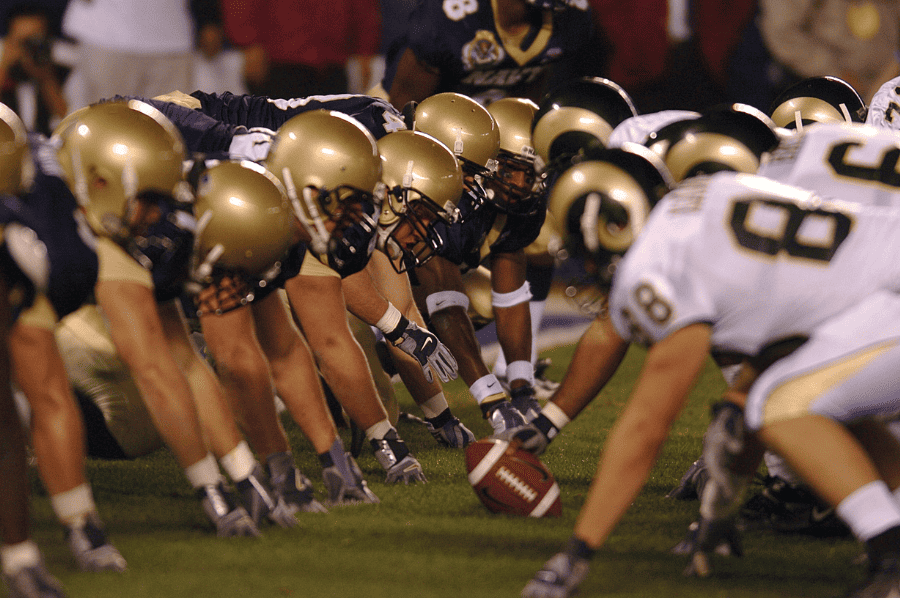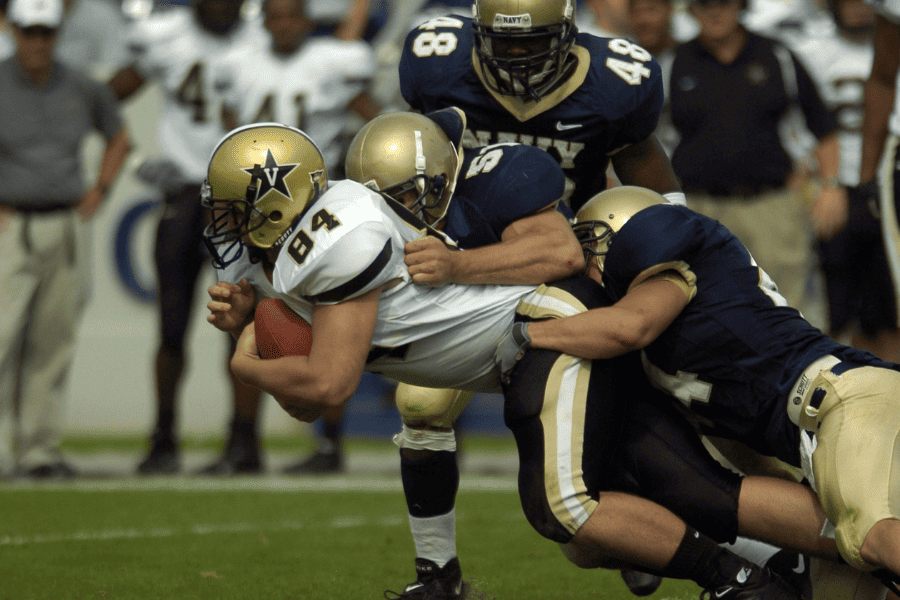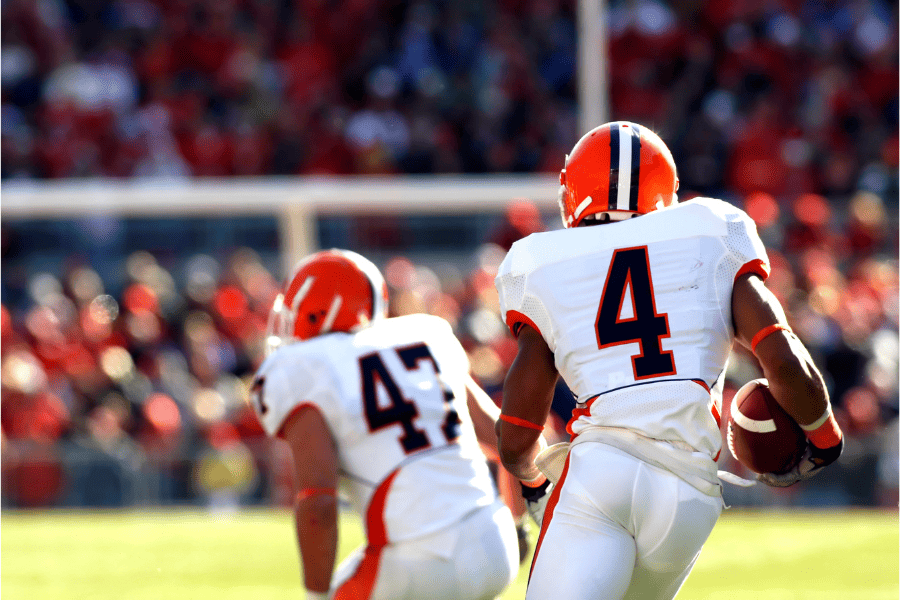What Does a Tight End Do in Football? (Simply Explained)
One of the most versatile and essential roles in football is that of the tight end.
Often considered a hybrid position due to the multifaceted nature of its responsibilities, a tight end is an offensive player who serves dual roles as both a blocker and a receiver. This position requires a unique blend of physical prowess, agility, and strategic understanding, making it a pivotal component in a team’s offensive strategy.
The tight end’s importance cannot be overstated. They are often a team’s secret weapon, providing critical support in both running and passing plays while keeping the opposing defense guessing.
Whether they’re blocking for the quarterback, creating an opening for a running back, or catching a crucial pass in a high-pressure situation, the tight end is undoubtedly a game-changer in the game of football. This article will dive into the evolving role of the tight end, and explain exactly what this position does on the football field.
Tight End – The Basics
Location on Field

The tight end typically lines up on the offensive line, next to the tackles, hence their name as they are “tightly” bound to the end of the line. Depending on the specific play or offensive scheme, the tight end can be found either to the right or left of the offensive line.
However, as the tight end position has evolved and become more versatile, you’ll find tight ends lined up both in the backfield and out wide as a wide receiver.
Physical Attributes and Skills of a Tight End
Given the multifaceted nature of their role, tight ends typically possess a combination of size, strength, agility, and speed. Most tight ends in the NFL stand between 6’3″ and 6’6″ tall and weigh between 240 and 260 pounds.
This size and build allow them to physically be able to block defensive ends, but also can make them a match-up nightmare for smaller linebackers and defensive backs trying to guard them on passing plays.
Tight ends require exceptional hand-eye coordination for catching passes, often in traffic. They also need to understand complex offensive strategies and quickly adapt to changing situations on the field, requiring a high football IQ.
In terms of skills, tight ends must excel in both blocking and receiving. Their blocking skills need to be on par (or at least close) with offensive linemen, helping to protect the quarterback or create running lanes for the running back.
As receivers, they need to run sharp routes, have the ability to catch the football reliably, and often have the speed and/or agility to gain yards after the catch.
Tight End Offensive Responsibilities
The role of a tight end in the offensive line is versatile and crucial. They are heavily involved in both the passing and running game, offering a dual-threat that can cause defensive headaches.
Blocking
One of the significant tasks of a tight end is blocking.
- For the Run Game
In the running game, tight ends are integral to creating paths for the running back to run through. They can block defensive ends, linebackers, or even defensive backs, depending on the specific play design.
A successful block by a tight end can open up significant running lanes, leading to substantial gains on the ground. This requires not only strength and size but also exceptional technique and the ability to understand defensive alignments.
Their positioning on the edge of the offensive line gives them the leverage to seal off defensive players, create gaps, or provide lead blocks on outside runs.
- For the Pass Game
In the passing game, tight ends can also play a crucial role in protecting the quarterback from oncoming rushers.
They help form the protective pocket around the quarterback, providing him with the time and space to identify open receivers and complete passes. When the quarterback drops back to pass, the tight end may be called upon to block defensive ends or blitzing linebackers, neutralizing them to prevent pressure on the quarterback.
In some passing situations, the tight end may initially stay in to block but then release into a pass route if their defensive assignment does not rush the quarterback, creating an additional receiving option. This is often referred to as a “check-release” assignment.
With all that being said, in today’s game of football tight ends are much more likely to be utilized as a wide receiver in the passing game rather than a blocker. Many modern tight ends are simply too big of a threat to not involve them in passing plays.
Receiving

While their blocking skills are essential, tight ends also have a significant role as receivers in the offense, contributing to their hybrid status on the field.
- Short-Yardage Situations
In short-yardage situations, when the team needs only a few yards to achieve a first down or score, the tight end can become a primary target.
The quick routes that they run in these situations, such as hitch or out routes, combined with their ability to use their bodies to shield away defenders, make them a reliable option for quarterbacks looking to move the chains.
- Red Zone Plays
Tight ends are particularly valuable in the red zone – the area between the 20-yard line and the opponent’s end zone. Their size gives them an advantage in this part of the field where space is limited.
They can use their height and jumping ability to catch high passes that smaller defenders can’t reach, making them excellent targets for touchdowns. Fade routes in the corner of the end zone are common ways tight ends are used in these situations.
- Creating Mismatches
Perhaps one of the most significant contributions of a tight end in the passing game is their ability to create mismatches against the defense. Their unique combination of size and speed can make it difficult for defenses to decide whether to guard them with a linebacker, who might struggle to keep up in coverage, or a smaller defensive back, who may be overpowered physically.
This mismatch can lead to substantial gains for the offense. A tight end running downfield against a smaller, outmatched defender can be an attractive target for a quarterback.
Special Teams and Other Roles

While their primary role is on offense, some tight ends may also contribute on special teams, depending on the team’s roster and the player’s specific skills. Given their combination of size, speed, and strength, tight ends can be effective in various roles on special teams.
They can be a part of the kickoff and punt return and coverage teams, using their speed to track down the returner or their size and strength to block for their own returner.
In field goal and extra point situations, a tight end may line up as part of the protective line, using their size and blocking skills to prevent the opposing team from blocking the kick. These special team roles can be crucial, as they impact the game’s hidden yardage and can often shift momentum.
Tight End in Different Football Strategies
The role of the tight end can vary significantly depending on the offensive system a team uses. Different systems prioritize different aspects of the game and utilize player positions in unique ways.
As a versatile player who can both block and receive, the tight end’s usage can dramatically change based on the offensive scheme.
For example, some systems may focus on the tight end primarily as a blocker, while others may utilize them more as a receiving threat. Additionally, the number of tight ends a team uses on any given play can also vary. Some systems often use two tight ends, while others predominantly feature one or occasionally even three.
Tight End in Popular Offensive Strategies
In the West Coast offense, which emphasizes short, horizontal passing routes and high-percentage throws, the tight end is often a critical component. They typically run shorter routes, acting as a safety valve for the quarterback.
Their size and catching ability make them a reliable target in this scheme, particularly on third downs or in the red zone. Moreover, their blocking ability is crucial in setting up the running game, another key element of the West Coast offense.
On the other hand, in an Air Raid offense, the role of the tight end might be less prominent. The Air Raid system heavily emphasizes passing, often spreading the field with multiple wide receivers.
In such systems, tight ends could be used less frequently, and when used, they might function more as additional receivers rather than blockers. However, when a tight end is utilized in this system, their ability to create mismatches can be a significant advantage.
In a run-heavy offense, such as the Power Run or the Option, the tight end’s blocking abilities are often the highlight. They are integral to creating running lanes and sealing off edges for the running back or the quarterback. However, they can also provide an element of surprise in the passing game due to the defense’s focus on the run.
These examples show that the role of the tight end is highly flexible and adaptable, making it a uniquely versatile position that can fit into and enhance many different offensive strategies.
How the Tight End Has Evolved Over the Years
The role of the tight end in American football has significantly evolved over the decades. In the early years of the NFL, the tight end was primarily a sixth offensive lineman who could catch passes. Their main duties were to block for running backs and provide occasional assistance in the passing game.
However, as the game became more pass-oriented, the role of the tight end began to change. They started to become more involved in the passing game, taking on the additional responsibilities of a receiver.
This evolution required tight ends to be not only strong and good at blocking but also fast and adept at catching the football.
Current Trends in the NFL
In the current NFL landscape, tight ends have become a central part of many teams’ offenses. They are often viewed as matchup nightmares for defenses due to their size and speed combination.
The modern tight end can line up in various spots on the field – next to the tackle, in the slot, out wide like a receiver, or even in the backfield. This positional flexibility allows offenses to create mismatches and exploit various defensive alignments.
Some of the league’s top tight ends are among their team’s leading receivers, demonstrating the increasing value of tight ends in the passing game.
Additionally, two tight end sets have also become more popular. These formations provide offenses with flexibility, as they can effectively run or pass from the same personnel grouping, keeping defenses guessing.
Legendary Tight Ends
The tight end position has seen several legendary players who have not only excelled in their roles but also influenced how the position is perceived and played. Here are a few notable examples:
- Mike Ditka: Mike Ditka was one of the first tight ends who showcased the potential of the position in the passing game. Playing primarily for the Chicago Bears in the 1960s, Ditka was a fierce competitor and excellent blocker, but also a remarkably gifted receiver. He was instrumental in changing the perception of the tight end from merely an extra blocker to a legitimate receiving threat.
- Kellen Winslow: Playing for the San Diego Chargers in the 1980s, Kellen Winslow was a key figure in the Air Coryell offense, an early precursor to today’s pass-heavy offenses. His exceptional receiving skills, combined with his size and speed, helped redefine the tight end position. Winslow often lined up as a wide receiver, exploiting mismatches against smaller defensive backs and slower linebackers.
- Tony Gonzalez: Arguably the greatest tight end in NFL history, Tony Gonzalez, who spent most of his career with the Kansas City Chiefs and the Atlanta Falcons, took the position to new heights. He combined excellent blocking skills with elite receiving ability, regularly leading his team in receptions, receiving yards, and receiving touchdowns. Gonzalez’s success highlighted the importance of the tight end position in modern offenses and paved the way for the next generation of tight ends.
- Rob Gronkowski: A key part of the New England Patriots’ successful run in the 2010s, Rob Gronkowski, or “Gronk,” exemplifies the modern tight end. At 6’6″ and 265 pounds, with exceptional athleticism and hands, Gronkowski is a matchup nightmare for defenses. He’s equally effective as a blocker and receiver, making him a crucial component of both the Patriots’ running and passing attacks.
- Travis Kelce: Currently playing for the Kansas City Chiefs, Travis Kelce represents the latest evolution of the tight end position. His route running and pass-catching abilities rival those of the best wide receivers in the league. Kelce is frequently among the league leaders in receiving yards and receptions, a testament to his role in the Chiefs’ dynamic offense.
These players, among others, have left an indelible mark on the tight end position. They have pushed the boundaries of what’s expected from a tight end, and their contributions to the game continue to shape the way tight ends are used in modern football.
Final Thoughts
The tight end position in American football is truly unique.
Occupying a hybrid role between offensive linemen and wide receivers, tight ends offer versatility that is unmatched on the football field. Their essential role in both running and passing plays underscores their value on offense.
Whether they are blocking to open up running lanes, protecting the quarterback in passing situations, or catching passes to advance the ball or score touchdowns, their contribution is significant and multifaceted.
The evolution of the tight end position reflects the broader changes in the game of football itself. As strategies have shifted and the passing game has gained prominence, tight ends have adapted to meet new demands and exploit new opportunities.
They have grown from their origins as an additional blocker to become essential cogs in the offensive machine, capable of creating mismatches against defenses and making game-changing plays.

